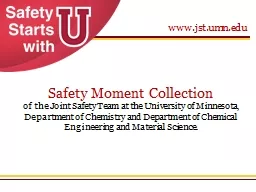

Identifying exposure assessing risk and mitigating risk Pregnancy and Chemical Research Researchers in chemical labs who are pregnant need to be aware of potential health hazards to them and their fetus ID: 777269
Download The PPT/PDF document "Pregnancy and Chemical Research" is the property of its rightful owner. Permission is granted to download and print the materials on this web site for personal, non-commercial use only, and to display it on your personal computer provided you do not modify the materials and that you retain all copyright notices contained in the materials. By downloading content from our website, you accept the terms of this agreement.
Slide1
Pregnancy and Chemical Research
Identifying exposure,
assessing
risk, and
mitigating risk
Slide2Pregnancy and Chemical Research
Researchers in chemical labs who are pregnant need to be aware of potential health hazards to them and their fetus
Teratogens
Ionizing radiationInfectious diseases
2
European Agency for Safety and Health at Work. Directive 2007/30/EC of the European Parliament and of the Council of 20 June 2007Kling, Jim “Alone in Lab.” Science Career Magazine 7 April 2006 <http://sciencecareers.sciencemag.org/career_magazine/previous_issues/articles/2006_04_07/nodoi.16787403986169116343>
When a worker becomes aware of a pregnancy, they should:Identify potential exposure to hazardsConsult resources regarding those hazardsDevelop risk mitigation strategies
Slide3Identifying Exposure
Chemical
Teratogens
BiologicalInfectious diseasesPhysicalNoise
RadiationExtreme cold/heatHeavy liftingPhysical fatigue (standing or sitting too long)
University of Minnesota Chemical Hygiene Plan accessed 4 April 2013 http://www.chem.umn.edu/services/safety/tables/tabXVIII.htmEuropean Agency for Safety and Health at Work. Directive 2007/30/EC of the European Parliament and of the Council of 20 June 2007
Examples of Known TeratogensArsenic, Cadmium, Lead, MercuryBenzene, Toluene, Xylene
Ethylene Oxide, Ethylene Glycol, Vinyl Chloride
Keep in mind that exposure limits are often
several orders of magnitude lower
for pregnant women due to fetus sensitivity. Exposure is especially significant in the first
14 to 60 days
of pregnancy.
Slide4Assessing Risk
Consult at least 2-3 health sources regarding hazard
Material safety data sheets (MSDS)
National Institute for Occupational Safety and Health (NIOSH)Occupational Safety and Health Administration (OSHA)Understand amount and duration of exposure
Consider volumes, concentrationsExposure testing is available through DEHS
Kling, Jim “Alone in Lab.” Science Career Magazine 7 April 2006 <http://sciencecareers.sciencemag.org/career_magazine/previous_issues/articles/2006_04_07/nodoi.16787403986169116343> MSDS for benzene
Slide5Mitigating Risk
Work with someone to develop a plan to avoid exposure to hazards
Principle Investigator
Lab Safety OfficerDEHS Contact
You can choose to treat all chemicals as potentially hazardous substancesUse engineering controls (hoods, shields)Always wear proper PPE; perhaps increase frequency of glove changes, consider splash apron, etc.
When in doubt, askDicks, Lynn “The Top 5 Challenges for Pregnant Scientists.” Science Career Magazine 7 April 2006 <http://sciencecareers.sciencemag.org/career_magazine/previous_issues/articles/2006_04_07/nodoi.10636024449169885694>
Pregnant workers who declare their pregnancy
have a right to request accommodation to avoid exposure to reproductive hazards
Slide6Additional Resources
Science Careers
magazine feature articles on Pregnancy & the Lab
http://sciencecareers.sciencemag.org/career_magazine/previous_issues/articles/2006_04_07/nodoi.14914624199943288521
1992 European Directive on pregnant women and new mothers (law in European Union, helpful ideas for discussing risk mitigation with superiors)
https://osha.europa.eu/data/legislation/10Departmental Chemical Hygiene Planhttp://www.chem.umn.edu/services/safety/ChemHygPlan.htmlInternational Labor Organization Reproductive Health Hazards Module (includes more comprehensive teratogen list)http://actrav.itcilo.org/actrav-english/telearn/osh/rep/prod.htm